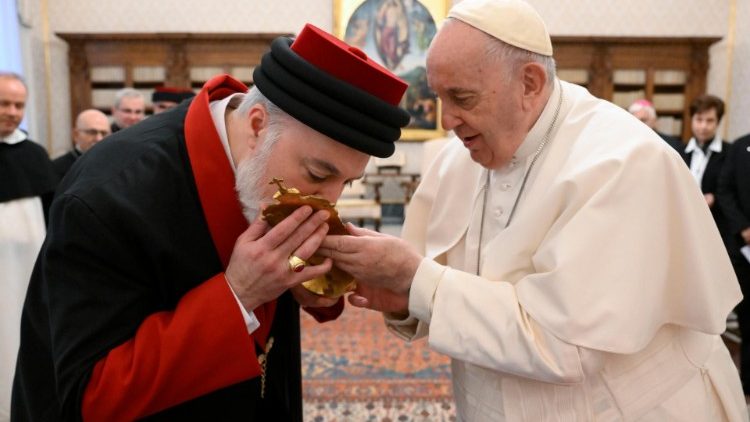Francis meets Mar Awa III: Isaac of Nineveh symbol of unity between Catholic and Assyrian Churches
In Rome, the pope and the catholicos of the Assyrian Church of the East hold an historic meeting, following in the footsteps of the Common Christological Declaration signed on 11 November 1994 by Saint John Paul II and Mar Dinkha IV. Isaac the Syrian, who stressed that holiness overcomes separations, is added to the Roman Martyrology. Speaking about Mideast Christians, the pontiff said: “may the Christians of the Middle East always bear witness to the Risen Christ in those war-torn lands.”
Vatican City (AsiaNews) – Qatar, Mosul (Iraq), and Iran are places where Christians have faced daily trials for years, including recurrent persecution, second-class status, intimidations, and flights. Yet it was here that Saint Isaac of Nineveh (also known as Isaac the Syrian) lived in the second half of the 7th century.
A monk and bishop, he followed the pre-Ephesian tradition, and is today "one of the most venerated Fathers of the Syro-Oriental tradition,” said Pope Francis today when he met in the Vatican Mar Awa III, catholicos (patriarch) of the Assyrian Church of the East.
With his inclusion by the bishop of Rome in the Roman Martyrology, the book containing the saints of the liturgical calendars, the Eastern mystic today is a symbol of the unity between the Catholic and the Assyrian Churches.
Francis had announced the inclusion during the historic audience in the Vatican with Mar Awa III, catholicos since 8 September 2021, a meeting to mark two important anniversaries in the relations between the two Churches divided for 1,500 years over various Christological controversies dating back to the Council of Ephesus (431).
The first meeting took place 40 years ago, in 1984, when the late Assyrian Catholicos Mar Dinkha IV visited Rome. On that occasion, Saint John Paul II laid down the foundations of the dialogue that led 10 years later – 30 years ago – to the Common Christological Declaration between the Catholic Church and the Assyrian Church of the East.
The statement, born from the “longing for unity,” called for the establishment of a joint commission for theological dialogue between the Catholic Church and the Assyrian Church of the East”.
The commission, which Francis also received in audience, “recently initiated a new phase of dialogue on the liturgy in the life of the Church,” reads a press release by the Dicastery for Promoting Christian Unity.
Born in present-day Qatar, where he had his first monastic experience, Saint Isaac was ordained bishop of Nineveh, a city near present-day Mosul (Iraq), by Catholicos Giwargis (George) I of Seleucia-Ctesiphon.
After a few months of episcopate, he asked to return to monastic life and retired to the monastery of Rabban Shabur in Beth Huzaye (Khuzestan, in present-day southwestern Iran), where he wrote numerous ascetic-spiritual texts that made him famous.
Although he belonged to a Church that was no longer in communion with any other, the writings of Isaac the Syrian, were translated into all the languages spoken by Christians.
The inclusion of Isaac the Syrian in the Roman Martyrology shows that holiness did not stop with separations and continues to exist beyond confessional boundaries. Hopefully, this will contribute to the rediscovery of his teachings and to the unity of all of Christ's disciples.
The final document of the Synod on Synodality that has just ended calls for the inclusion in the liturgical calendar of Saints and witnesses of the faith from other Churches (like Saint Isaac), “a gift that we can accept”.
Pope Francis spoke about the 1994 Declaration during the audience with Mar Awa III and the Joint Commission for Theological Dialogue between the Catholic Church and the Assyrian Church of the East.
That historic text “recognized the legitimacy and accuracy of the varied expressions of our common Christological faith as formulated by the Fathers in the Nicene Creed.” The Commission set up following the document “has borne remarkable fruit, also at the pastoral level.”
Francis mentioned the 2001 agreement on the Anaphora of the Apostles Addai and Mari, which gave “our respective faithful a certain communicatio in sacris in particular circumstances,” the 2017 Common Declaration on "sacramental life," as well as the more recent The Images of the Church in the Syriac and Latin Patristic Traditions, which “laid the foundation for a common understanding of the Church’s constitution.”
“Theological dialogue is indispensable in our journey towards unity, since the unity we yearn for is unity in faith, while the dialogue of truth must never be separated from the dialogue of charity and the dialogue of life,” the pontiff said, addressing the theologians members of the Commission. Thus, holy lives become the "best guides on the path to full communion".
“Through the intercession of Saint Isaac of Nineveh, united to that of the Blessed Virgin Mary, Mother of Christ, our God and Saviour, may the Christians of the Middle East always bear witness to the Risen Christ in those war-torn lands,” Francis added at the end of his speech.
“[M]ay the friendship between our Churches continue to flourish, until the blessed day when we can celebrate together at the same altar and receive the communion of the same Body and Blood of the Saviour”.
Francis went on to thank the Catholicos of the Assyrian Church of the East, and urged everyone to work and walk together on the "road to full unity".
At the end, all shared the recitation of the Lord's Prayer: “Let each one pray it according to his or her own tradition and language, in a low voice.”
09/09/2021 09:44







.png)










